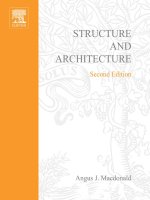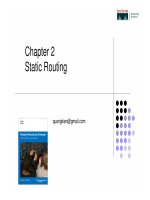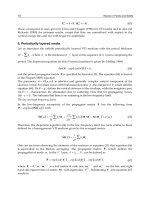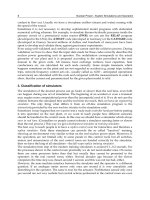Structure and Architecture - Chapter 2 pot
Bạn đang xem bản rút gọn của tài liệu. Xem và tải ngay bản đầy đủ của tài liệu tại đây (345.92 KB, 13 trang )
2.1 Introduction
To perform its function of supporting a
building in response to whatever loads may be
applied to it, a structure must possess four
properties: it must be capable of achieving a
state of equilibrium, it must be stable, it must
have adequate strength and it must have
adequate rigidity. The meanings of these terms
are explained in this chapter. The influence of
structural requirements on the forms which are
adopted for structures is also discussed. The
treatment is presented in a non-mathematical
way and the definitions which are given are not
those of the theoretical physicist; they are
simply statements which are sufficiently
precise to allow the significance of the
concepts to structural design to be
appreciated.
2.2 Equilibrium
Structures must be capable of achieving a
state of equilibrium under the action of
applied load. This requires that the internal
configuration of the structure together with
the means by which it is connected to its
foundations must be such that all applied
loads are balanced exactly by reactions
generated at its foundations. The
wheelbarrow provides a simple demonstration
of the principles involved. When the
wheelbarrow is at rest it is in a state of static
equilibrium. The gravitational forces
generated by its self weight and that of its
contents act vertically downwards and are
exactly balanced by reacting forces acting at
the wheel and other supports. When a
horizontal force is applied to the wheelbarrow
by its operator it moves horizontally and is
not therefore in a state of static equilibrium.
This occurs because the interface between the
wheelbarrow and the ground is incapable of
generating horizontal reacting forces. The
wheelbarrow is both a structure and a
machine: it is a structure under the action of
gravitational load and a machine under the
action of horizontal load.
Despite the famous statement by one
celebrated commentator, buildings are not
machines
1
. Architectural structures must,
therefore, be capable of achieving equilibrium
under all directions of load.
2.3 Geometric stability
Geometric stability is the property which
preserves the geometry of a structure and
allows its elements to act together to resist
load. The distinction between stability and
equilibrium is illustrated by the framework
shown in Fig. 2.1 which is capable of achieving
a state of equilibrium under the action of
gravitational load. The equilibrium is not
stable, however, because the frame will
collapse if disturbed laterally
2
.
9
Chapter 2
Structural requirements
1 ‘A house is a machine for living.’ Le Corbusier.
2 Stability can also be distinguished from strength or
rigidity, because even if the elements of a structure
have sufficient strength and rigidity to sustain the
loads which are imposed on them, it is still possible
for the system as a whole to fail due to its being
geometrically unstable as is demonstrated in
Fig. 2.1.
This simple arrangement demonstrates
that the critical factor, so far as the stability
of any system is concerned, is the effect on it
of a small disturbance. In the context of
structures this is shown very simply in Fig. 2.2
by the comparison of tensile and compressive
elements. If the alignment of either of these is
disturbed, the tensile element is pulled back
into line following the removal of the
disturbing agency but the compressive
element, once its initially perfect alignment
has been altered, progresses to an entirely
new position. The fundamental issue of
stability is demonstrated here, which is that
stable systems revert to their original state
following a slight disturbance whereas unstable
systems progress to an entirely new state.
The parts of structures which tend to be
unstable are the ones in which compressive
forces act and these parts must therefore be
given special attention when the geometric
stability of an arrangement is being
considered. The columns in a simple
rectangular framework are examples of this
(Fig. 2.1). The three-dimensional bridge
structure of Fig. 2.3 illustrates another
potentially unstable system. Compression
occurs in the horizontal elements in the upper
parts of this frame when the weight of an
object crossing the bridge is carried. The
arrangement would fail by instability when this
load was applied due to inadequate restraint
of these compression parts. The compressive
internal forces, which would inevitably occur
Structure and Architecture
10
Fig. 2.1 A rectangular frame with four hinges is capable
of achieving a state of equilibrium but is unstable because
any slight lateral disturbance to the columns will induce it
to collapse. The frame on the right here is stabilised by the
diagonal element which makes no direct contribution to
the resistance of the gravitational load.
Fig. 2.2 The tensile
element on the left here is
stable because the loads
pull it back into line
following a disturbance. The
compressive element on
the right is fundamentally
unstable.
Original alignment
Fig. 2.3 The horizontal
elements in the tops of
the bridge girders are
subjected to
compressive internal
force when the load is
applied. The system is
unstable and any
eccentricity which is
present initially causes
an instability-type
failure to develop.
Compression
Tension
with some degree of eccentricity, would push
the upper elements out of alignment and
cause the whole structure to collapse.
The geometric instability of the
arrangements in Figures 2.1 and 2.3 would
have been obvious if their response to
horizontal load had been considered (Fig. 2.4).
This demonstrates one of the fundamental
requirements for the geometric stability of any
arrangement of elements, which is that it must
be capable of resisting loads from orthogonal
directions (two orthogonal directions for plane
arrangements and three for three-dimensional
arrangements). This is another way of saying
that an arrangement must be capable of
achieving a state of equilibrium in response to
forces from three orthogonal directions. The
stability or otherwise of a proposed
arrangement can therefore be judged by
considering the effect on it of sets of mutually
perpendicular trial forces: if the arrangement is
capable of resisting all of these then it is
stable, regardless of the loading pattern which
will actually be applied to it in service.
Conversely, if an arrangement is not capable of
resisting load from three orthogonal directions
then it will be unstable in service even though
the load which it is designed to resist will be
applied from only one direction.
It frequently occurs in architectural design
that a geometry which is potentially unstable
must be adopted in order that other
architectural requirements can be satisfied. For
example, one of the most convenient structural
geometries for buildings, that of the
rectangular frame, is unstable in its simplest
hinge-jointed form, as has already been shown.
Stability can be achieved with this geometry by
the use of rigid joints, by the insertion of a
diagonal element or by the use of a rigid
diaphragm which fills up the interior of the
frame (Fig. 2.5). Each of these has
disadvantages. Rigid joints are the most
convenient from a space-planning point of
view but are problematic structurally because
they can render the structure statically
indeterminate (see Appendix 3). Diagonal
elements and diaphragms block the framework
and can complicate space planning. In multi-
panel arrangements, however, it is possible to
produce stability without blocking every panel.
The row of frames in Fig. 2.6, for example, is
stabilised by the insertion of a single diagonal.
11
Structural requirements
Fig. 2.4 Conditions for stability of frameworks. (a) The
two-dimensional system is stable if it is capable of
achieving equilibrium in response to forces from two
mutually perpendicular directions. (b) The three-
dimensional system is stable if it is capable of resisting
forces from three directions. Note that in the case
illustrated the resistance of transverse horizontal load is
achieved by the insertion of rigid joints in the end bays.
(a)
(b)
Fig. 2.5 A rectangular frame can be stabilised by the
insertion of (a) a diagonal element or (b) a rigid
diaphragm, or (c) by the provision of rigid joints. A single
rigid joint is in fact sufficient to provide stability.
Fig. 2.6 A row of rectangular frames is stable if one panel
only is braced by any of the three methods shown in Fig. 2.5.
(a) (b) (c)
Where frames are parallel to each other the
three-dimensional arrangement is stable if a
few panels in each of the two principal
directions are stabilised in the vertical plane
and the remaining frames are connected to
these by diagonal elements or diaphragms in
the horizontal plane (Fig. 2.7). A three-
dimensional frame can therefore be stabilised
by the use of diagonal elements or diaphragms
in a limited number of panels in the vertical
and horizontal planes. In multi-storey
arrangements these systems must be provided
at every storey level.
None of the components which are added
to stabilise the geometry of the rectangular
frame in Fig. 2.7 makes a direct contribution to
the resistance of gravitational load (i.e. the
carrying of weight, either of the structure itself
or of the elements and objects which it
supports). Such elements are called bracing
elements. Arrangements which do not require
bracing elements, either because they are
fundamentally stable or because stability is
provided by rigid joints, are said to be self-
bracing.
Most structures contain bracing elements
whose presence frequently affects both the
initial planning and the final appearance of the
building which it supports. The issue of
stability, and in particular the design of
bracing systems, is therefore something which
affects the architecture of buildings.
Where a structure is subjected to loads from
different directions, the elements which are
used solely for bracing when the principal load
is applied frequently play a direct role in
resisting secondary load. The diagonal
elements in the frame of Fig. 2.7, for example,
would be directly involved in the resistance of
any horizontal load which was applied, such as
might occur due to the action of wind. Because
real structures are usually subjected to loads
from different directions, it is very rare for
elements to be used solely for bracing.
The nature of the internal force in bracing
components depends on the direction in which
the instability which they prevent occurs. In
Fig. 2.8, for example, the diagonal element will
be placed in tension if the frame sways to the
right and in compression if it sways to the left.
Because the direction of sway due to instability
cannot be predicted when the structure is
being designed, the single bracing element
would have to be made strong enough to carry
either tension or compression. The resistance
of compression requires a much larger size of
cross-section than that of tension, however,
especially if the element is long
3
, and this is a
critical factor in determining its size. It is
normally more economical to insert both
diagonal elements into a rectangular frame
Structure and Architecture
12
Fig. 2.7 These
frames contain
the minimum
number of
braced panels
required for
stability.
3 This is because compression elements can suffer from
the buckling phenomenon. The basic principles of this
are explained in elementary texts on structures such as
Engel, H., Structural Principles, Prentice-Hall, Englewood
Cliffs, NJ, 1984. See also Macdonald, Angus J., Structural
Design for Architecture, Architectural Press, Oxford, 1997,
Appendix 2.
(cross-bracing) than a single element and to
design both of them as tension-only elements.
When the panel sways due to instability the
element which is placed in compression simply
buckles slightly and the whole of the restraint
is provided by the tension diagonal.
It is common practice to provide more
bracing elements than the minimum number
required so as to improve the resistance of
three-dimensional frameworks to horizontal
load. The framework in Fig. 2.7, for example,
although theoretically stable, would suffer
considerable distortion in response to a
horizontal load applied parallel to the long side
of the frame at the opposite end from the
vertical-plane bracing. A load applied parallel to
the long side at this end of the frame would also
cause a certain amount of distress as some
movement of joints would inevitably occur in the
transmission of it to the vertical-plane bracing at
the other end. In practice the performance of the
frame is more satisfactory if vertical-plane
bracing is provided at both ends (Fig. 2.9). This
gives more restraint than is necessary for
stability and makes the structure statically
indeterminate (see Appendix 3), but results in
the horizontal loads being resisted close to the
points where they are applied to the structure.
Another practical consideration in relation
to the bracing of three-dimensional rectangular
frames is the length of the diagonal elements
which are provided. These sag in response to
their own weight and it is therefore
advantageous to make them as short as
possible. For this reason bracing elements are
frequently restricted to a part of the panel in
which they are located. The frame shown in
Fig. 2.10 contains this refinement.
Figures 2.11 and 2.12 show typical bracing
systems for multi-storey frameworks. Another
common arrangement, in which floor slabs act
as diaphragm-type bracing in the horizontal
plane in conjunction with vertical-plane
bracing of the diagonal type, is shown in Fig.
2.13. When the rigid-joint method is used it is
13
Structural requirements
Fig. 2.8 Cross-bracing is used so that sway caused by
instability is always resisted by a diagonal element acting
in tension. The compressive diagonal buckles slightly and
carries no load.
Fig. 2.9 In practical bracing schemes more elements
than are strictly necessary to ensure stability are provided
to improve the performance of frameworks in resisting
horizontal load. Frame (a) is stable but will suffer
distortion in response to horizontal load on the side walls.
Its performance is enhanced if a diagonal element is
provided in both end walls (b). The lowest framework (c)
contains the minimum number of elements required to
resist effectively horizontal load from the two principal
horizontal directions. Note that the vertical-plane bracing
elements are distributed around the structure in a
symmetrical configuration.
(a)
(b)
(c)
Fig. 2.10 In practice, bracing elements are frequently
confined to a part of each panel only.
normal practice to stabilise all panels
individually by making all joints rigid. This
eliminates the need for horizontal-plane
bracing altogether, although the floors
normally act to distribute through the
structure any unevenness in the application of
horizontal load. The rigid-joint method is the
normal method which is adopted for
reinforced concrete frames, in which
continuity through junctions between
elements can easily be achieved; diaphragm
bracing is also used, however, in both vertical
and horizontal planes in certain types of
reinforced concrete frame.
Loadbearing wall structures are those in
which the external walls and internal partitions
serve as vertical structural elements. They are
normally constructed of masonry, reinforced
Structure and Architecture
14
Fig. 2.13 Concrete floor slabs are normally used as
horizontal-plane bracing of the diaphragm type which acts
in conjunction with diagonal bracing in the vertical planes.
Fig. 2.12 These drawings of floor grid patterns for steel
frameworks show typical locations for vertical-plane bracing.
Fig. 2.11 A typical bracing scheme for a multi-storey
framework. Vertical-plane bracing is provided in a limited
number of bays and positioned symmetrically on plan. All
other bays are linked to this by diagonal bracing in the
horizontal plane at every storey level.
concrete or timber, but combinations of these
materials are also used. In all cases the joints
between walls and floors are normally
incapable of resisting bending action (in other
words they behave as hinges) and the resulting
lack of continuity means that rigid-frame
action cannot develop. Diaphragm bracing,
provided by the walls themselves, is used to
stabilise these structures.
A wall panel has high rotational stability in
its own plane but is unstable in the out-of-
plane direction (Fig. 2.14); vertical panels
must, therefore, be grouped in pairs at right
angles to each other so that they provide
mutual support. For this to be effective the
structural connection which is provided in the
vertical joint between panels must be capable
of resisting shear
4
. Because loadbearing wall
structures are normally used for multi-cellular
buildings, the provision of an adequate
number of vertical-plane bracing diaphragms
in two orthogonal directions is normally
straightforward (Fig. 2.15). It is unusual
therefore for bracing requirements to have a
significant effect on the internal planning of
this type of building.
The need to ensure that a structural
framework is adequately braced is a factor that
can affect the internal planning of buildings.
The basic requirement is that some form of
bracing must be provided in three orthogonal
planes. If diagonal or diaphragm bracing is
used in the vertical planes this must be
accommodated within the plan. Because
vertical-plane bracing is most effective when it
is arranged symmetrically, either in internal
cores or around the perimeter of the building,
this can affect the space planning especially in
tall buildings where the effects of wind loading
are significant.
2.4 Strength and rigidity
2.4.1 Introduction
The application of load to a structure
generates internal forces in the elements and
external reacting forces at the foundations (Fig.
2.16) and the elements and foundations must
15
Structural requirements
4 See Engel, H., Structural Principles, Prentice-Hall,
Englewood Cliffs, NJ, 1984 for an explanation of shear.
Fig. 2.14 Walls are
unstable in the
out-of-plane direction
and must be grouped
into orthogonal
arrangements for
stability.
Fig. 2.15 Loadbearing masonry buildings are normally
multi-cellular structures which contain walls running in
two orthogonal directions. The arrangement is inherently
stable.
have sufficient strength and rigidity to resist
these. They must not rupture when the peak
load is applied; neither must the deflection
which results from the peak load be excessive.
The requirement for adequate strength is
satisfied by ensuring that the levels of stress
which occur in the various elements of a
structure, when the peak loads are applied, are
within acceptable limits. This is chiefly a
matter of providing elements with cross-
sections of adequate size, given the strength of
the constituent material. The determination of
the sizes required is carried out by structural
calculations. The provision of adequate rigidity
is similarly dealt with.
Structural calculations allow the strength
and rigidity of structures to be controlled
precisely. They are preceded by an assessment
of the load which a structure will be required
to carry. The calculations can be considered to
be divisible into two parts and to consist firstly
of the structural analysis, which is the
evaluation of the internal forces which occur in
the elements of the structure, and secondly,
the element-sizing calculations which are
carried out to ensure that they will have
sufficient strength and rigidity to resist the
internal forces which the loads will cause. In
many cases, and always for statically
indeterminate structures (see Appendix 3), the
two sets of calculations are carried out
together, but it is possible to think of them as
separate operations and they are described
separately here.
2.4.2 The assessment of load
The assessment of the loads which will act on
a structure involves the prediction of all the
different circumstances which will cause load
to be applied to a building in its lifetime (Fig.
2.17) and the estimation of the greatest
Structure and Architecture
16
Fig. 2.16 The structural elements of a building conduct
the loads to the foundations. They are subjected to
internal forces that generate stresses the magnitudes of
which depend on the intensities of the internal forces and
the sizes of the elements. The structure will collapse if the
stress levels exceed the strength of the material.
magnitudes of these loads. The maximum load
could occur when the building was full of
people, when particularly heavy items of
equipment were installed, when it was exposed
to the force of exceptionally high winds or as a
result of many other eventualities. The
designer must anticipate all of these
possibilities and also investigate all likely
combinations of them.
The evaluation of load is a complex process,
but guidance is normally available to the
designer of a structure from loading
standards
5
. These are documents in which data
and wisdom gained from experience are
presented systematically in a form which
allows the information to be applied in design.
2.4.3 The analysis calculations
The purpose of structural analysis is to
determine the magnitudes of all of the forces,
internal and external, which occur on and in a
structure when the most unfavourable load
conditions occur. To understand the various
processes of structural analysis it is necessary
to have a knowledge of the constituents of
structural force systems and an appreciation of
concepts, such as equilibrium, which are used
to derive relationships between them. These
topics are discussed in Appendix 1.
In the analysis of a structure the external
reactions which act at the foundations and the
internal forces in the elements are calculated
from the loads. This is a process in which the
structure is reduced to its most basic abstract
form and considered separately from the rest
of the building which it will support.
An indication of the sequence of operations
which are carried out in the analysis of a
simple structure is given in Fig. 2.18. After a
preliminary analysis has been carried out to
evaluate the external reactions, the structure is
subdivided into its main elements by making
‘imaginary cuts’ (see Appendix 1.7) through the
junctions between them. This creates a set of
‘free-body-diagrams’ (Appendix 1.6) in which
the forces that act between the elements are
17
Structural requirements
5 In the UK the relevant standard is BS 6399, Design
Loading for Buildings, British Standards Institution, 1984.
Fig. 2.17 The prediction of the maximum load which will occur is one of the most problematic aspects of structural
calculations. Loading standards are provided to assist with this but assessment of load is nevertheless one of the most
imprecise parts of the structural calculation process.
exposed. Following the evaluation of these
inter-element forces the individual elements
are analysed separately for their internal forces
by further applications of the ‘imaginary cut’
technique. In this way all of the internal forces
in the structure are determined.
In large, complex, statically indeterminate
structures the magnitudes of the internal
forces are affected by the sizes and shapes of
the element cross-sections and the properties
of the constituent materials, as well as by the
magnitudes of the loads and the overall
geometry of the structure. The reason for this
is explained in Appendix 3. In these
circumstances the analysis and element-sizing
calculations are carried out together in a trial
and error process which is only feasible in the
context of computer-aided design.
The different types of internal force which
can occur in a structural element are shown in
Fig. 2.19. As these have a very significant
influence on the sizes and shapes which are
specified for elements they will be described
briefly here.
In Fig. 2.19 an element is cut through at a
particular cross-section. In Fig. 2.19(a) the
forces which are external to one of the
Structure and Architecture
18
Fig. 2.18 In structural analysis the complete structure is
broken down into two-dimensional components and the
internal forces in these are subsequently calculated. The
diagram shows the pattern forces which result from
gravitational load on the roof of a small building. Similar
breakdowns are carried out for the other forms of load and
a complete picture is built up of the internal forces which
will occur in each element during the life of the structure.
Uniformly distributed
Fig. 2.19 The investigation of internal forces in a simple
beam using the device of the ‘imaginary cut’. The cut
produces a free-body-diagram from which the nature of the
internal forces at a single cross-section can be deduced.
The internal forces at other cross-sections can be
determined from similar diagrams produced by cuts made
in appropriate places. (a) Not in equilibrium. (b) Positional
equilibrium but not in rotational equilibrium. (c)
Positional and rotational equilibrium. The shear force on
the cross-section 1.5 m from the left-hand support is
15 kN; the bending moment on this cross-section is
22.5 kNm.
(a)
(b)
(c)
resulting sub-elements are marked. If these
were indeed the only forces which acted on the
sub-element it would not be in a state of
equilibrium. For equilibrium the forces must
balance and this is clearly not the case here;
an additional vertical force is required for
equilibrium. As no other external forces are
present on this part of the element the extra
force must act on the cross-section where the
cut occurred. Although this force is external to
the sub-element it is an internal force so far as
the complete element is concerned and is
called the ‘shear force’. Its magnitude at the
cross-section where the cut was made is
simply the difference between the external
forces which occur to one side of the cross-
section, i.e. to the left of the cut.
Once the shear force is added to the
diagram the question of the equilibrium of
the sub-element can once more be
examined. In fact it is still not in a state of
equilibrium because the set of forces now
acting will produce a turning effect on the
sub-element which will cause it to rotate in a
clockwise sense. For equilibrium an anti-
clockwise moment is required and as before
this must act on the cross-section at the cut
because no other external forces are present.
The moment which acts at the cut and which
is required to establish rotational
equilibrium is called the bending moment at
the cross-section of the cut. Its magnitude is
obtained from the moment equation of
equilibrium for the free-body-diagram. Once
this is added to the diagram the system is in
a state of static equilibrium, because all the
conditions for equilibrium are now satisfied
(see Appendix 1).
Shear force and bending moment are forces
which occur inside structural elements and
they can be defined as follows. The shear force
at any location is the amount by which the
external forces acting on the element, to one
side of that location, do not balance when they
are resolved perpendicular to the axis of the
element. The bending moment at a location in
an element is the amount by which the
moments of the external forces acting to one
side of the location, about any point in their
plane, do not balance. Shear force and bending
moment occur in structural elements which are
bent by the action of the applied load. Beams
and slabs are examples of such elements.
One other type of internal force can act on
the cross-section of an element, namely axial
thrust (Fig. 2.20). This is defined as the amount
by which the external forces acting on the
element to one side of a particular location do
not balance when they are resolved parallel to
the direction of the element. Axial thrust can
be either tensile or compressive.
In the general case each cross-section of a
structural element is acted upon by all three
internal forces, namely shear force, bending
moment and axial thrust. In the element-sizing
part of the calculations, cross-section sizes are
determined that ensure the levels of stress
which these produce are not excessive. The
efficiency with which these internal forces can
be resisted depends on the shape of the cross-
section (see Section 4.2).
19
Structural requirements
Fig. 2.20 The ‘imaginary cut’ is a device for exposing
internal forces and rendering them susceptible to
equilibrium analysis. In the simple beam shown here shear
force and bending moment are the only internal forces
required to produce equilibrium in the element isolated by
the cut. These are therefore the only internal forces which
act on the cross-section at which the cut was made. In the
case of the portal frame, axial thrust is also required at the
cross-section exposed by the cut.
(a) (b)
(c) (d)
The magnitudes of the internal forces in
structural elements are rarely constant along
their lengths, but the internal forces at any
cross-section can always be found by making
an ‘imaginary cut’ at that point and solving the
free-body-diagram which this creates.
Repeated applications of the ‘imaginary cut’
technique at different cross-sections (Fig.
2.21), allows the full pattern of internal forces
to be evaluated. In present-day practice these
calculations are processed by computer and
the results presented graphically in the form of
bending moment, shear force and axial thrust
diagrams for each structural element.
The shapes of bending moment, shear force
and axial thrust diagrams are of great
significance for the eventual shapes of
structural elements because they indicate the
locations of the parts where greatest strength
will be required. Bending moment is normally
large in the vicinity of mid-span and near rigid
joints. Shear force is highest near support
joints. Axial thrust is usually constant along
the length of structural elements.
2.4.4 Element-sizing calculations
The size of cross-section which is provided for
a structural element must be such as to give it
adequate strength and adequate rigidity. In
other words, the size of the cross-section must
allow the internal forces determined in the
analysis to be carried without overloading the
structural material and without the occurrence
of excessive deflection. The calculations which
are carried out to achieve this involve the use
of the concepts of stress and strain (see
Appendix 2).
In the sizing calculations each element is
considered individually and the area of cross-
section determined which will maintain the
stress at an acceptable level in response to the
peak internal forces. The detailed aspects of
the calculations depend on the type of internal
force and, therefore, the stress involved and on
the properties of the structural material.
As with most types of design the evolution
of the final form and dimensions of a structure
is, to some extent, a cyclic process. If the
element-sizing procedures yield cross-sections
which are considered to be excessively large or
unsuitable in some other way, modification of
the overall form of the structure will be
undertaken so as to redistribute the internal
forces. Then, the whole cycle of analysis and
element-sizing calculations must be repeated.
If a structure has a geometry which is stable
and the cross-sections of the elements are
sufficiently large to ensure that it has adequate
strength it will not collapse under the action of
the loads which are applied to it. It will
therefore be safe, but this does not necessarily
mean that its performance will be satisfactory
(Fig. 2.22). It may suffer a large amount of
Structure and Architecture
20
Fig. 2.21 The magnitudes of internal forces normally vary
along the length of a structural element. Repeated use of
the ‘imaginary cut’ technique yields the pattern of internal
forces in this simple beam.
deflection under the action of the load and any
deformation which is large enough to cause
damage to brittle building components, such
as glass windows, or to cause alarm to the
building’s occupants or even simply to cause
unsightly distortion of the building’s form is a
type of structural failure.
The deflection which occurs in response to a
given application of load to a structure
depends on the sizes of the cross-sections of
the elements
6
and can be calculated once
element dimensions have been determined. If
the sizes which have been specified to provide
adequate strength will result in excessive
deflection they are increased by a suitable
amount. Where this occurs it is the rigidity
requirement which is critical and which
determines the sizes of the structural
elements. Rigidity is therefore a phenomenon
which is not directly related to strength; it is a
separate issue and is considered separately in
the design of structures.
2.5 Conclusion
In this chapter the factors which affect the basic
requirements of structures have been reviewed.
The achievement of stable equilibrium has
been shown to be dependent largely on the
geometric configuration of the structure and is
therefore a consideration which affects the
determination of its form. A stable form can
almost always be made adequately strong and
rigid, but the form chosen does affect the
efficiency with which this can be accomplished.
So far as the provision of adequate strength is
concerned the task of the structural designer is
straightforward, at least in principle. He or she
must determine by analysis of the structure the
types and magnitudes of the internal forces
which will occur in all of the elements when the
maximum load is applied. Cross-section shapes
and sizes must then be selected such that the
stress levels are maintained within acceptable
limits. Once the cross-sections have been
determined in this way the structure will be
adequately strong. The amount of deflection
which will occur under the maximum load can
then be calculated. If this is excessive the
element sizes are increased to bring the
deflection within acceptable limits. The
detailed procedures which are adopted for
element sizing depend on the types of internal
force which occur in each part of the structure
and on the properties of the structural
materials.
21
Structural requirements
6 The deflection of a structure is also dependent on the
properties of the structural material and on the overall
configuration of the structure.
Fig. 2.22 A structure with adequate strength will not
collapse, but excessive flexibility can render it unfit for its
purpose.









